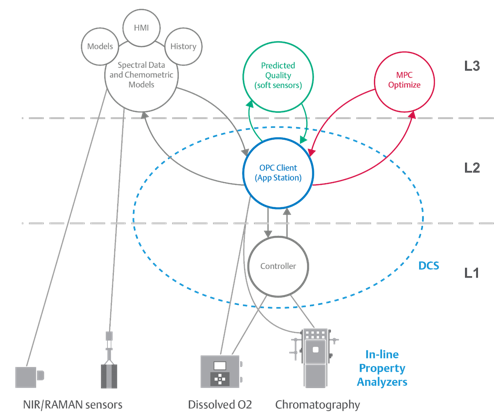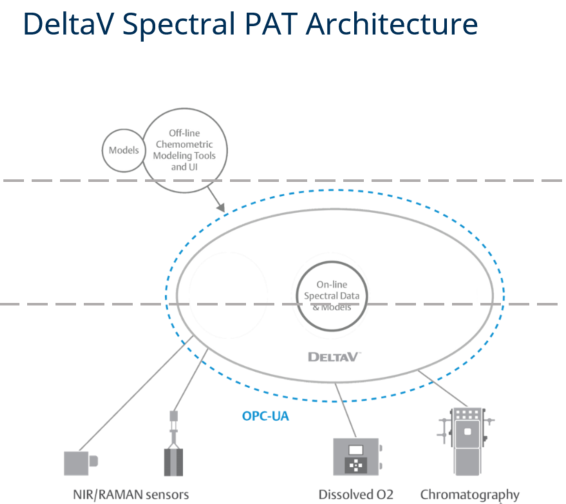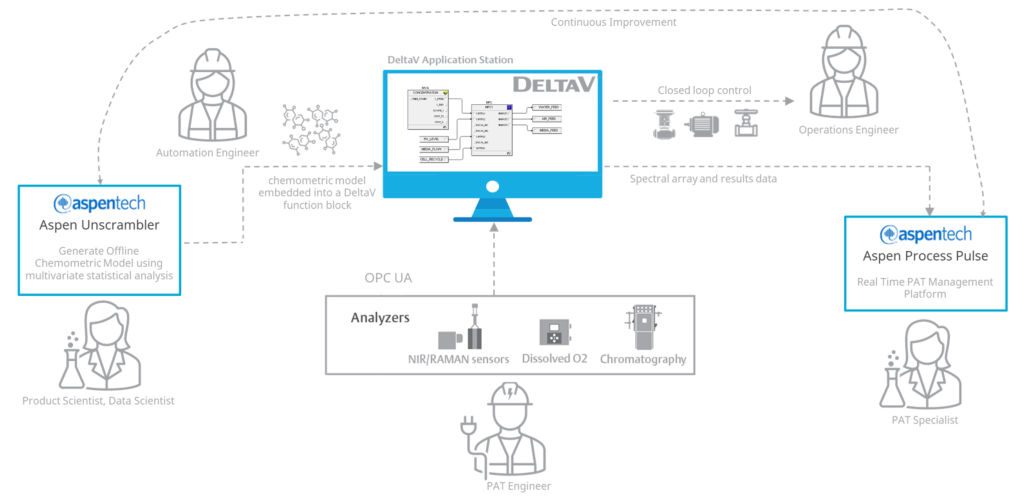Real-time manual sampling has been a tried-and-true manufacturing practice for decades. But this antiquated approach has been subject to the risk of human error, time-sensitive, and time-consuming. Today’s digital technologies have enabled manufacturers to automate and improve this process.
At the IFPAC-2023 meeting, Emerson’s Bruce Greenwald and Aspen Technology’s Geir Rune Flåten teamed together to present, Deploying a Rugged PAT Model Infrastructure for Real-Time Monitoring and Control. They opened by sharing the voice of customers in the Life Sciences industry.

Typical spectral analyzer integration with control system
Their needs include getting new products to market faster, making different products more quickly, supplying products in full-time, and releasing products faster. The manufacturing processes require pipeline acceleration, more flexible manufacturing, operational integrity, and real-time release capabilities. to drive improvements.
Bruce and Geir shared BioPhorum’s Five Levels of Digital Plant Maturity Model and where Process Analytical Technologies (PAT) could be applied. These areas include reducing islands of real-time Process Analytics at level 3—the Connected Plant. At level 4, the Predictive Plant, these areas include using advanced production technologies, online/at-line quality testing with Real-Time Release, and applying integrated real-time process analytics. At the model’s highest level, 5, the Adaptive Plant, PAT strategies can be applied to provide in-line, real-time, continuous, closed-loop process verification and control with automated real-time quality release.
To drive operational improvements with closed-loop, real-time monitoring, and control, models for real-time monitoring are required, along with spectral data from spectrometers and historical lab data. The challenge with spectral analyzers is that they are typically hard to integrate with the automation architecture.

DeltaV Spectral PAT provides a fully integrated solution.
Bruce noted that solutions such as DeltaV Spectral PAT simplify this architecture by bringing this data directly into the DeltaV distributed control system. This integrated solution collapses the traditional PAT architecture by bringing spectral signals directly into DeltaV and performing chemometric model calculations within real-time control module execution. The DeltaV system’s OPC UA client reads the spectral array signals and is accessed directly by the PAT model function block running in DeltaV control modules. This approach is ideal for critical quality attribute calculations for real-time monitoring and closed-loop control within the DeltaV control system.
Geir Rune highlighted the use of AspenTech Aspen Process Pulse Real-Time PAT Management Platform and how it enables pharmaceutical or biopharmaceutical PAT specialists to drive continuous improvements with the process and data scientists who use Aspen Unscrambler, which generates offline chemometric models using multivariate statistical analysis. The applications and DeltaV Spectral PAT enable end-to-end PAT monitoring and closed-loop control.

Robust & rugged PAT solution with Aspen Unscrambler, Aspen Process Pulse, and DeltaV Spectral PAT.
Visit the links above for more information on how these applications help you deploy a robust and rugged PAT model infrastructure for real-time monitoring and control to drive operational improvements.




